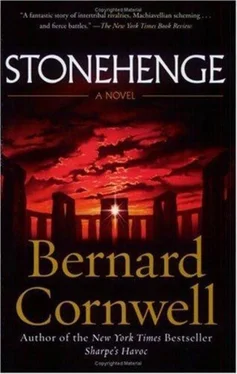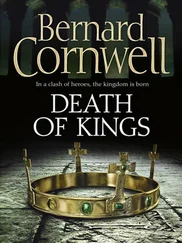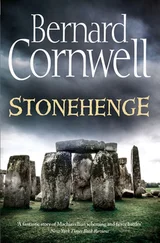Sannas spat on the gold, then shuffled back into the deep darkness of the hut where her fire was little more than a heap of charred embers. 'You can sleep inside the door,' she said from the darkness, 'or outside. I do not care.'
Camaban did not answer, but just stared at the great temple stones. The shadows of the lovers were motionless now, but the dying firelight flickered and it seemed to him that the ring of stones was shimmering in the smoky night. It was as though the stones were alive and the people were dead, and that made him think of the Old Temple, so far away, that was his home, and he leaned forward and put his forehead on the ground and swore to whatever gods were listening that he would make the Old Temple live. He would make it dance, he would make it sing, he would make it live.
—«»—«»—«»—
Hengall was pleased with the results of his negotiations with Kital. Peace was assured, and that peace would be sealed by the marriage of Saban and Derrewyn. 'Not that she's the girl I'd have chosen for you,' Hengall grumbled to his son as they walked south towards Ratharryn. 'She's much too thin.'
'Too thin?' Saban asked. He had thought Derrewyn beautiful.
'Women are no different from cattle,' Hengall said. 'The best have wide rumps. It's no use marrying a thin thing, they just die in childbirth. But Sannas decided you're to marry Derrewyn and the marriage will seal our peace, so that's the end of it.'
Hengall had not only agreed to the marriage, he had also bought eight great boulders with which Gilan could remake the Old Temple. The price for the stones had been one of the large gold lozenges and nine of the small, which Hengall reckoned cheap. It was right, he thought, to exchange a small part of Sarmennyn's gold for the stones for he was sure now that the arrival of the treasures had been a message from Slaol to remake the Old Temple and Gilan had convinced him that Ratharryn must possess a temple made of stone.
There was no stone at Ratharryn. There were pebbles in the river, and a few larger rocks that could be shaped into hammers or axes, but the settlement had no big stones to rival the pillars and slabs that ringed Cathallo's temple. Ratharryn was a place of chalk, grass and trees, while Cathallo's land was rich in the great boulders which lay so thickly scattered on their hills that from a distance they looked like a flock of giant grey sheep. Sannas contended that the stones had been flung there by Slaol in a vain attempt to stop the people of Cathallo from raising the sacred mound to Lahanna, though others said that the rocks had been cast onto the hills by Gewat, the god of the clouds, who had wanted to see his own likeness on the earth's green face, but however the stones had reached Cathallo, they were the closest boulders to Ratharryn.
Saban liked the idea of building something new and impressive at Ratharryn. A few of Hengall's folk muttered that timber temples had always served Ratharryn well enough, but the traders, those men who carried hides and flint and pots to exchange for axes and shellfish and salt, pointed out that Drewenna possessed a large stone temple and that nearly all the shrines in the distant west were also made of boulders, and the prospect of a stone temple of their own served to revive the spirits of most of Hengall's people. A new temple, made of stone, might restore the tribe's luck, and that belief was enough to persuade the priests that Gilan should be the new high priest. They reported as much to Hengall, and the chief, who had bribed four of the priests with bronze bars, Outfolk slave girls and lumps of amber to make just such a choice, gravely accepted the verdict as having come from the gods.
So Gilan became the new high priest and his first demand was that the tribe should clear the Old Temple of its weeds and hazels so that the shrine would be ready for the arrival of Cathallo's stones in the new year.
The men did the work, while the women stayed outside the bank and danced in a ring. They sang as they danced and their song was the wedding chant of Slaol. Only women ever sang that beautiful song, and only on occasions of the deepest solemnity. It went in snatches, with long pauses between the music, and during the pauses the dancers would stand quite motionless, before, seemingly without anyone telling them when, the steps and the singing would begin again. Their voices overlaid each other in a twisting harmony and, though they never practised the song together, it always sounded hauntingly lovely and the steps always stopped and started in perfect unison. Mothers taught the parts of the song to their daughters, and some learned one part and others learned another, and then they came together and everything fitted. Many of the women cried as they danced, for the song was a lament. On the day before the marriage of Slaol and Lahanna the sun god had fought with his bride and deserted her, but the women lived in hope that Slaol would relent and come back to his bride.
Gilan supervised the work, sometimes stopping to listen to the women's song and at other times helping the men grub out the weeds and shrubs. A few of the hazels were good-sized trees and their roots needed loosening with antler picks before they could be dragged clear of the soil. The trees could not simply be cut down, for hazel will grow again from its stump, so the bigger trees were hauled out and their root holes filled with a chalky rubble dug from the ditch. The ox-skull that Camaban had placed in the temple's centre was buried in the ditch, his lair was pulled down, the weeds were grubbed out, the grass cut with flint knives and the waste burned. The smoke from the fire disturbed the dancers so that they moved farther away from the temple as the men cleared the grass and weeds from the ditch and inner bank so that the shrine was again ringed with its bright chalk-white circle.
The old rotting posts that had stood so thick in the entrance of the sun and about the death house were tossed onto the fire. Some of the posts had been huge and their remains were buried deep: those were snapped off at ground level and their stubborn stumps left to decay. And once all the weeds, trees and posts had been cleared, the men danced across the wide circle to the haunting rhythm of the women's song. The temple was bare again, clean. It was a low grassy bank, a ditch and a high bank ringing a circle that held nothing.
The tribe returned to Ratharryn in the evening light. Galeth was one of the last to leave and he paused at the brow of the hill above the settlement to turn and look at the temple. The clump of hazels which had broken the southern skyline was gone so that only the grave mounds of the ancestors could be seen on that horizon, but in front of the mounds, white against the darkening hillside, the temple's ring seemed to shine in the dying light. The shadows of the bank stretched long and Galeth noticed, for the very first time, how the ring of chalk had been placed on a slope so that it was very slightly tilted towards the place where the sun rose in midsummer.
'It looks beautiful,' Lidda, Galeth's woman, said.
'It does look beautiful,' Galeth agreed. It was Galeth, practical, strong and efficient, who would have to raise the stones, and he tried to imagine how the eight great boulders would look in that clean setting of grass and chalk. 'Slaol will be pleased,' he decided.
There was thunder that night, but no rain. Just thunder, far off, and in the darkness two of the tribe's children died. Both had been sick, though no one had thought they would die. But in the morning the sun rose to make the newly cleared chalk-ring shine, and the gods, folk reckoned, were once again smiling on Ratharryn.
—«»—«»—«»—
Derrewyn was not yet a woman, but it was a custom in both Ratharryn and Cathallo that betrothed girls would live with their prospective husband's family, so Derrewyn came to Ratharryn to live in the hut of Hengall's oldest surviving wife.
Читать дальше
Конец ознакомительного отрывка
Купить книгу












